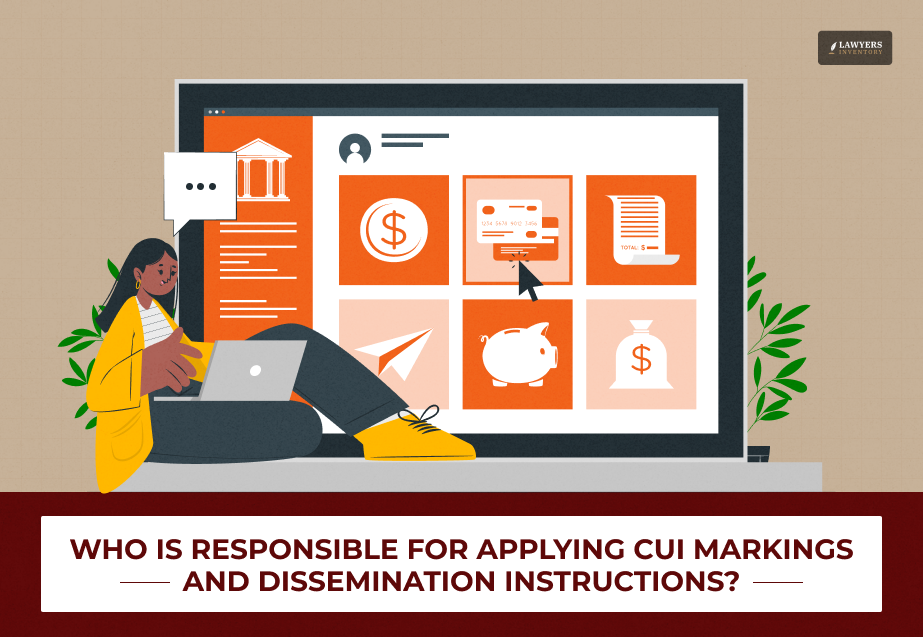
- Created under the leadership of former President Barack Obama, the CUI program aims to create a method of sharing information and safeguarding the same in a streamlined manner.
- The information present in the CUI repository is/are always in accordance with the “law, regulation, or government-wide policy” as stated in the DoD Mandatory CUI Training study.
- As per the record, the person who is responsible for applying CUI markings and dissemination instructions is generally the “authorized holder” who was present at the time of creation of the information.
Controlled Unclassified Information (CUI) refers to forms of unclassified yet sensitive information that require safeguarding and controlled dissemination.
Determining who bears responsibility for marking CUI and outlining dissemination procedures is critical to ensuring federal compliance and protecting sensitive data.
If you want to know who is responsible for applying CUI markings and dissemination instructions, it is important for you to understand how this entire thing works.
In this article, you will get to know:
- What is CUI, and why do the markings matter?
- Who is responsible for applying CUI markings and dissemination instructions?
- What is the role and responsibility of the person responsible for the CUI markings?
- The workflow of the CUI from creation to dissemination.
So, if these are the things that you want to know, keep on reading!
What Is CUI And Why Do The Markings Matter?
CUI is a category of unclassified information that must be protected under specific laws, regulations, or government-wide policies, per Executive Order 13556.
It replaces a variety of legacy designations—such as For Official Use Only (FOUO) and Sensitive But Unclassified (SBU)—to unify labeling and handling across federal agencies.
The official document from the General Services Administration clearly states that all forms of CUI documents should be “marked and protected according to applicable laws, regulations, and Government-wide policies.”
Proper CUI markings are essential for informing recipients that certain handling, access, and dissemination protocols apply. They guide authorized users on safeguarding measures, dissemination constraints, and decontrol requirements.
The document goes on to mention how the CUI markings that the authorized holder lists in the CUI Registry are the “only markings authorized to designate unclassified information requiring safeguarding or dissemination controls.”
Who Is An Authorized Holder In CUI Markings?
An authorized holder is the individual or organizational entity legally permitted to designate, apply, and handle CUI. This typically refers to the creator, originator, or holder at the time of creation.
Here are some of the most important roles and responsibilities of the authorized holder in the CUI markings:
At the time of information creation, this authorized holder is tasked with:
- Determining CUI status: Ascertaining if the information falls under the CUI program.
- Applying the correct markings: Including banner/footer labels specifying category (e.g., CUI Basic or CUI Specified) and any dissemination or control flags.
- Establishing dissemination instructions: These include things like limitations (e.g., NOFORN, Limited Dissemination Controls).
So, to answer your question, the authorized holder of the information at the time of creation is the person who is responsible for applying CUI markings and dissemination instructions.
Who Are The Other Responsible Parties in The CUI Ecosystem?
While the authorized holder manages initial marking and dissemination instructions, other stakeholders play vital roles in the broader CUI program.
1. CUI Designating Officials
These individuals—typically agency officials—determine whether information qualifies as CUI, based on applicable authorities. They guide the authorized holders in categorization and designation.
2. Information Owners And Program Managers
Information owners or data stewards ensure CUI under their domain is correctly marked and handled. Cuik Trac mentions that the “program managers and supervisors are responsible for ensuring that their teams understand CUI requirements and adhere to marking protocols.”
3. CUI Program Managers/Coordinators
Tasked with developing agency-level policies, training, and ensuring CUI roles are understood, these administrators act as the central hub for compliance.
4. ISOO (CUI Executive Agent)
The Information Security Oversight Office (ISOO), part of NARA, serves as the Executive Agent for the CUI Program. It does the following things:
- Oversees policy implementation.
- Guides agencies.
- Operates the CUI Registry—the authoritative list of CUI categories, markings, and control instructions.
5. Agency-Level Implementation
Federal agencies are responsible for applying CUI markings when sharing with non-federal entities, ensuring proper training, and setting up internal compliance mechanisms.
6. Defense Department (DoD) Leadership
Under DoD Instruction 5200.48, DoD’s implementation structure spells out roles:
- USD(A&S), USD(R&E), DoD CIO drives policy, technical standards, metadata tagging, and integration into systems.
- Component Heads must appoint a CUI SAO (Senior Agency Official) and a Component Program Manager to oversee compliance and resource allocation.
What Is The CUI Workflow?
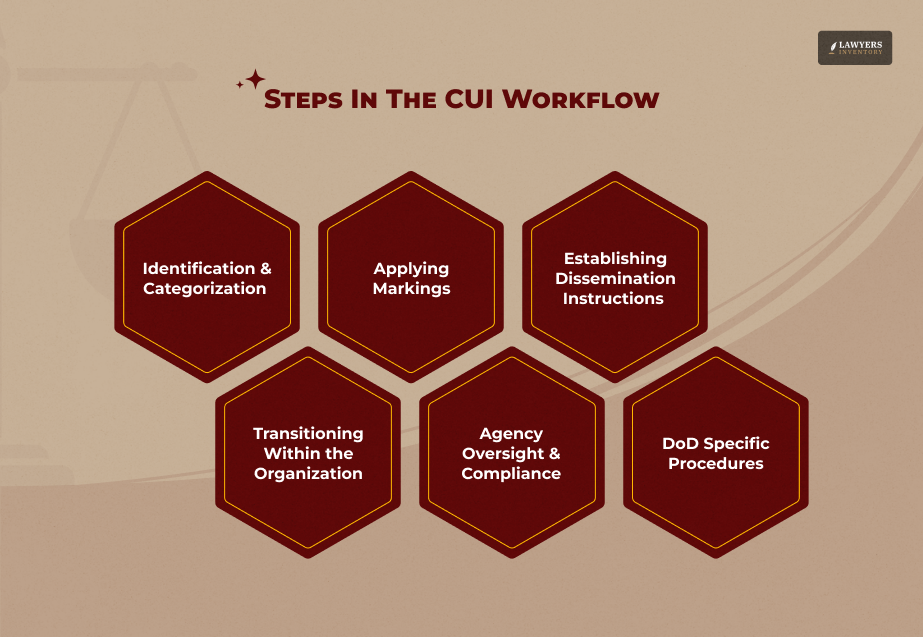
The entire workflow from creation to the dissemination of the CUI data and information is extremely streamlined.
The primary steps that are included in the process are as follows:
- Identification & Categorization.
- Applying markings.
- Establishing dissemination instructions.
- Transitioning within the organization.
- Agency oversight and compliance.
- DoD specific procedures.
Here’s how it all works:
1. Identification & Categorization
When creating content, the authorized holder must determine whether it qualifies as CUI, referencing the CUI Registry. If categorized as CUI, the holder must apply the right controls.
2. Applying Markings
Marking involves the Banner/Footer. This generally consists of the following:
- CUI control marking (required).
- Specific category if applicable (e.g., CUI//SP-PRVCY).
- Any Limited Dissemination Control (e.g., “REL TO…” or “NOFORN”).
3. Establishing Dissemination Instructions
The holder must specify dissemination limits. These instructions include things like who can access it, under what conditions, and any required transport or access restrictions.
4. Transitioning Within the Organization
Supervisors, program managers, and program coordinators oversee adherence to marking and dissemination protocols.
5. Agency Oversight & Compliance
SAOs, program managers, and ISOO monitor agency compliance and provide a governance structure. Contractors must follow marking instructions only when specified in contracts.
6. DoD Specific Procedures
Within DoD, metadata tagging, system integration, and policy enforcement fall under designated leaders and offices, ensuring consistency and oversight.
Who Does What In The CUI Marking And Dissemination Process?
Here is a complete list of the stakeholders and their roles and responsibilities when it comes to the CUI marking and dissemination process:
| Stakeholder | Responsibilities |
| Authorized Holder (creator) | Identify CUI, apply markings, and establish dissemination controls |
| CUI Designating Officials | Determine CUI eligibility, guide categorization |
| Info Owners / Program Managers | Ensure consistent marking and adherence to policies |
| CUI Program Managers / Coordinators | Manage training, procedures, and agency CUI compliance |
| ISOO (NARA – CUI EA) | Maintain CUI Registry, oversee implementation across agencies |
| Agency Heads / SAOs / Component Leads | Appoint CUI governance roles, allocate resources, and ensure policy compliance |
| DoD Execution (per DoDI 5200.48) | Define metadata standards, integration, and technical controls across systems |
| Federal Contractors | Follow marking/dissemination controls only when specified in contracts |
How Agencies Safeguard Sensitive Data?
The primary responsibility for applying CUI markings and establishing dissemination instructions rests with the authorized holder of the information at the time of its creation.
However, effective CUI management involves a multifaceted governance structure including:
- Designating officials.
- Program managers.
- Oversight agencies like ISOO.
- Department-specific leadership.
By recognizing both this individual-level accountability and the broader organizational framework, agencies can ensure sensitive data remains protected while enabling efficient and compliant information sharing.
Read Also:
- Section Officers in the US: Clerical Job or a Powerful Position?
- Is Section 8 Getting Cut Off: Answering The Most Asked!
- What Proof Do You Need for a Restraining Order?




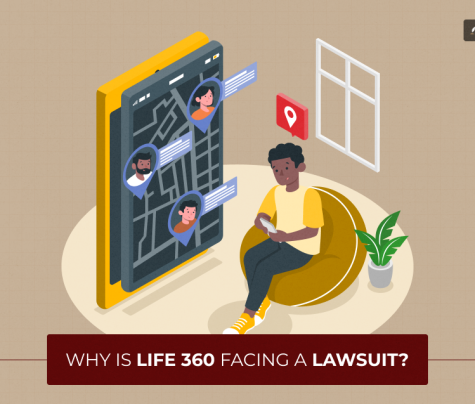
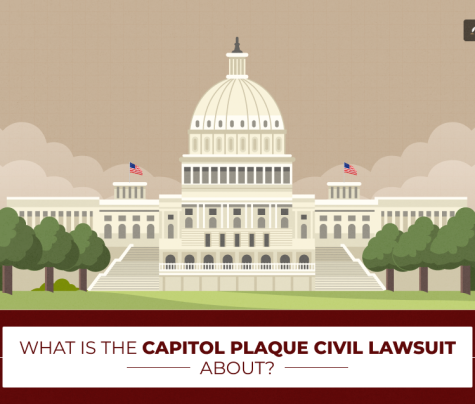
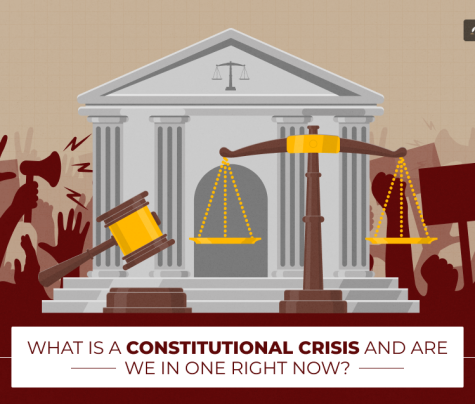



0 Reply
No comments yet.